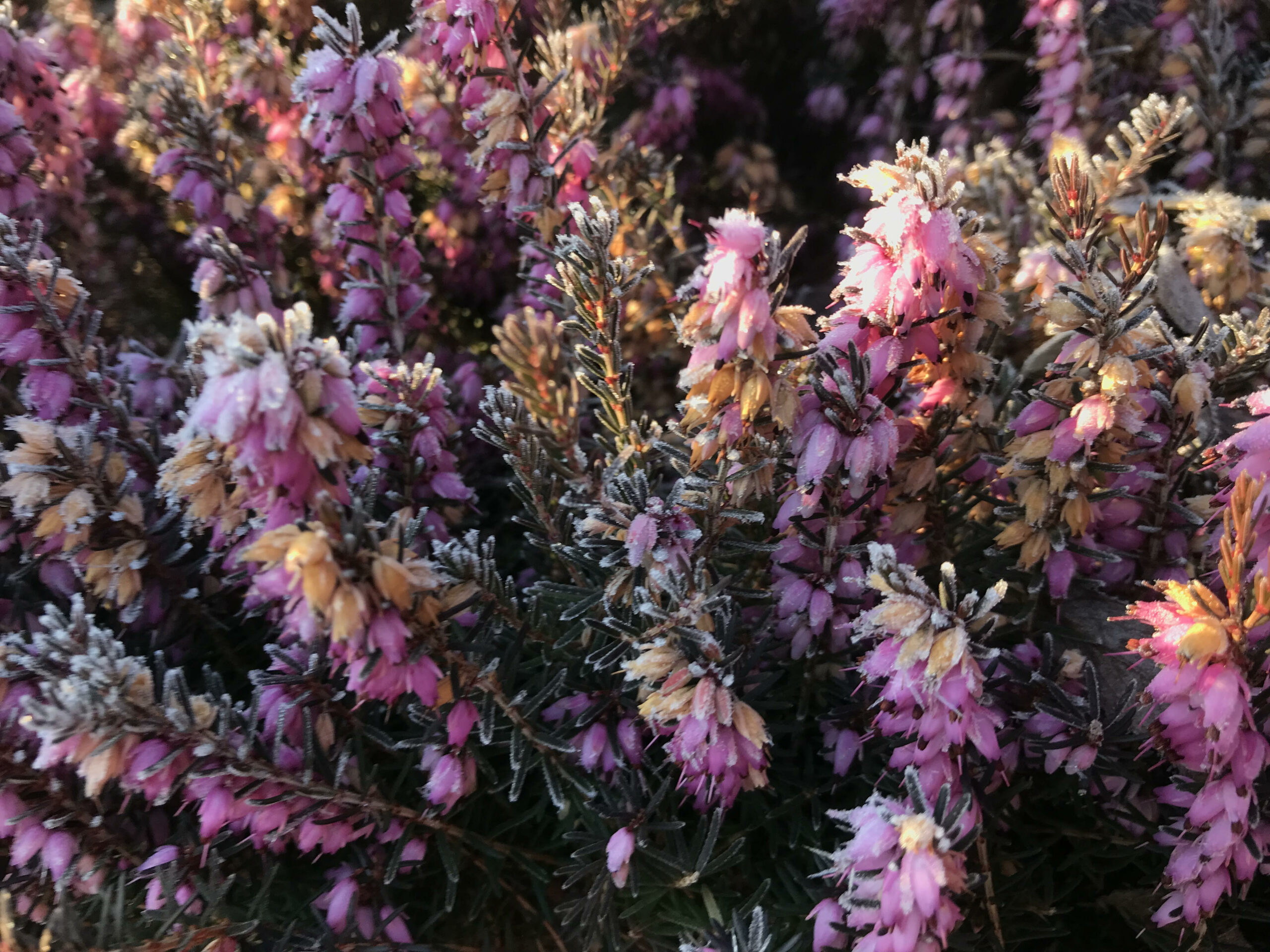Nine early blooming flowers

There’s something very cheering about the sight of a plant bravely flowering at this time of year, despite the elements. It’s not just humans that appreciate early-flowering plants; bees and other nectar and pollen-hungry insects depend on them too. They particularly need food sources at a time of year when they first venture from the hive, such as on warm days in late winter or early spring.
You can help your local bee populations survive and even recover from the winter by having a wide selection of late winter and early spring-flowering plants in a garden or on a balcony. The ideal is to have something in flower every day of the year, but if space is tight or budgets are limited, then it’s a good tactic to focus on providing food for the hardest times of year for bees. You can leave the summer months to other gardens and gardeners, as there’s plenty to choose from then, but in the January-March period there isn’t much for bees to nourish themselves and their hives.

Small trees, like Chimonanthus praecox, or “wintersweet” are easy to include in a family or school garden. They make an attractive feature planted on their own, or combine well with other shrubs and perennials in a mixed border. As well as their beautiful butter-yellow petals, up close you can see the gorgeous contrast of the deep red centres. Once you get near to the plant you can enjoy the fragrance, which is the real appeal of this, and many other winter-flowering shrubs. In order to attract pollinators from far and wide, the plant needs to smell sweet and distinctive. This plant has a fragrance somewhere between that of cloves and honey, and is well worth a trip down the garden on a warm day, or better yet, plant it by a door so you can enjoy the smell without even putting on your boots. Like many winter-flowering plants, the flowers of Chimonanthus are slightly waxy, which helps them to resist the rain, and hang down from the leafless branches, also to help the rain to drip straight off without damaging the pollen.
Viburnums come in all shapes and sizes, a genus of shrubs and small trees that thrive in the Northern Hemisphere with a few, more unusual members managing to survive in Asia and Africa too. Two particular members of the genus are fantastic for providing nectar and pollen for bees in early spring. The first is Viburnum tinus, which is a very adaptable evergreen shrub. If left unpruned it gets to about 3m tall and wide, but is easy to prune if you want to keep it shorter, and can make a good hedge plant. The smaller varieties, like the very pretty “Lisarose” or “Eve Price” will thrive for many years in containers on a balcony. The deep red buds appear before Christmas, and the white or pink flowers open gradually during warm spells until late March.

Viburnum bodnantense is a deciduous cousin of the Viburnum tinus, and is worth including in a garden for the wonderful flowers and attractive foliage. As you might expect of a plant named after a garden in Wales (the wonderful Bodnant garden, owned by the National Trust, near Conway) it is very cold-hardy, coping easily with temperatures down to -15C, and is unfussy about soil and situation. I have mine in a cramped spot between a Portuguese laurel and a tulip tree, and it flowers beautifully every January. Like the Viburnum tinus, the flowers take a while to open, over several weeks, which maximises their usefulness to bees, as well as their period of interest to gardeners. I particularly like the cultivar “Dawn” for the exorbitantly pink flowers and superb perfume. It’s not suitable for pots, as the branches quickly get tall and unbalanced, but you can cut the stems before the buds open and enjoy the fragrance and colour in vases in the house.
If you don’t have space for big plants like this, or want to be able to enjoy them close to the house, then there are lots of options for nectar-rich winter and spring-flowering plants that are perfect for pots.
Hellebores, also called Christmas or Lenten roses, depending on the species, have been known in Europe since the medieval period, and were used by the Ancient Greeks to treat a variety of ailments. Their use today is more ornamental than medicinal, and their very pretty flowers in a wide range of colours, from green, to white, pinks, purples, reds and even some deep greys, make a great addition to any winter container or flower bed. The bees will thank you if you choose the flowers with the simplest forms, as the nectar and pollen are more easily available in these plants. The fancier the flower, with double or even triple rows of petals, the less likely it is that the bee will be able to access the nectar, so if you, like me, love these fancy forms, add in a couple of plain ones as well to help the bees. Many people treat hellebores as annuals, and just keep them in pots for the winter, but they are, in fact, long-lived perennials, and you can easily re-plant them in a shady spot in the garden after they have finished flowering, where they will give you years of interest. You will see that the different varieties readily hybridise, with new colours popping up every year.
Heathers are a staple of winter colour containers, and their very long flowering period provides bees and pollinators with essential nectar-rich food sources, as well as giving a big splash of colour for us humans. Avoid the sprayed versions in weird colours, they don’t flower as well as their unsprayed cousins, even though the dye is vegetable-based, and instead stick to the classic pink, purple and white-flowered cultivars. You’ll find three species grouped together under the common name of “heathers” or “heaths”, Erica, Calluna and Daboecia, and it’s the Ericas that mostly flower in winter, and are of most interest for solitary bees and other pollinators. They combine really well with other winter-flowering container-friendly plants like hellebores and cyclamen, and you can pop in some bulbs underneath the plants to give some extra colour later in the season. When they’ve finished flowering, you can plant them in the garden, where they prefer an open, sunny spot.

We all know how good honey is for our health, not just for sore throats, but also for healing wounds and minor burns. Did you know that heather helps bees to fight off a common gut parasite? The chemical, called callunene, is found in Calluna vulgaris, a summer-flowering heather. If you want to give your local bees a boost, maybe you could find a little spot in your garden for some Calluna vulgaris too?
Winter aconite or Eranthis hyemalis is a fantastic ground-cover plant that is very easy to grow. It is a member of the buttercup family, with attractive cupped bright yellow flowers. It is typical of forest floor plants, as the flowers and leaves appear very early in the season, usually around March, before the leaves in the woodland canopy have opened, and die back by mid-summer, when the light levels have declined. You can grow it under trees in the garden, or leave it to naturalise in grass, either planting the bulbs in autumn, or the plants “in the green” (with their leaves, after flowering) in late spring. Bees and other pollinators go crazy for the nectar and pollen in these easy-access, open flowers. One of my favourite patches of aconites is in the Bern Rosengarten, where they are combined with crocuses and hellebores in a wonderful winter-beating planting.

Crocuses are probably the easiest of all spring-flowering bulbs. They are small, robust, cheap to buy, and although one or two might get dug up by squirrels, they seem to be less attractive to being nibbled by mice than some other bulbs. Once planted, they flower year after year, slowly increasing their numbers as the bulbs, or “corms” as they are actually called, create offsets, which are small bulblets, that will grow into adult flowering corms. They are the ultimate no-nonsense, low-maintenance, spring splash of happiness for gardeners. Luckily, bees love them too, particularly for early emerging queen bumble bees, solitary bees and foraging worker bees, looking to replenish their stocks of pollen. The majority of crocuses will provide this, and nectar, but if you have a choice, look for the varieties that flower earliest in the year. There are also autumn-flowering crocuses, which do very well in pots, and in rockeries or in a sheltered position under other shrubs. They provide essential fat stores for bees late in the season to help them survive the winter. You could even try growing saffron crocuses, Crocus sativa, which are autumn flowering, and enjoy a feast for the eyes and the taste buds, as well as helping our furry buzzing friends.

Author Bio
Hester Macdonald is a garden designer, broadcaster, and founder of the Swiss Gardening School. She is also the author of “Gardens Schweiz Suisse Switzerland”, a trilingual (English/French/German) guide to the 52 best gardens open to public across Switzerland, published by Bergli Books, available in all good book shops.
